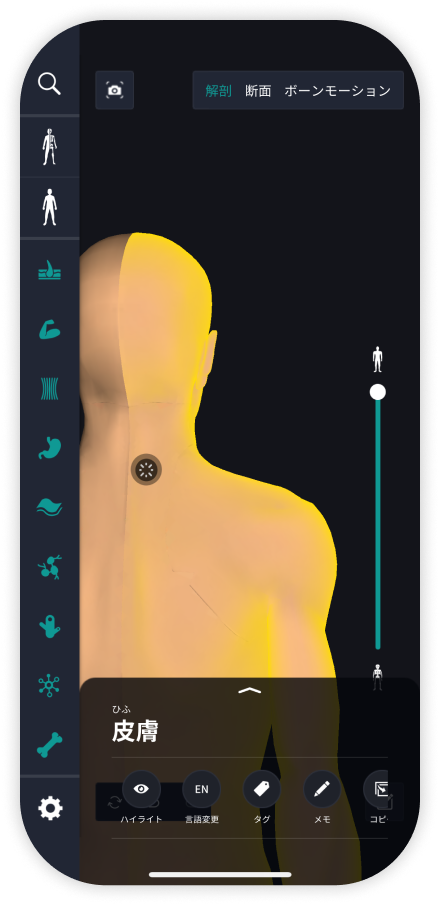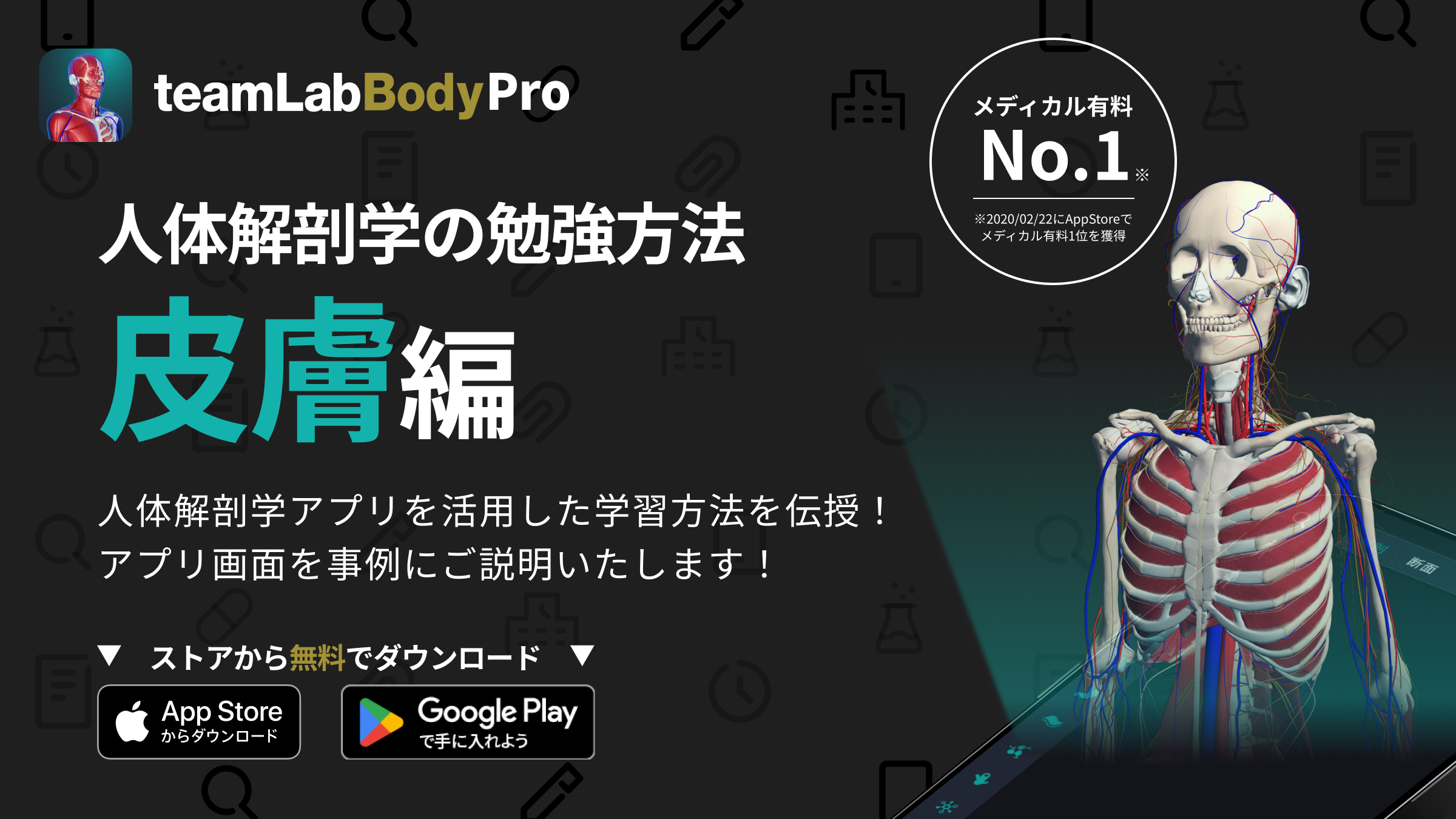beginning
In this article, I will explain effective study methods, starting with knowledge of specialized parts in human anatomy.
In human anatomy, it is necessary not only to memorize the names of various organs, muscles, and bones, but also to remember where they are located in the body. Therefore, it is necessary to learn as efficiently as possible.
I hope you will deepen your understanding even a little by reading this article and using the app.
Now, I'll explain the content about “skin” and how to study human anatomy.
teamLab Body Pro Free Download
A 3D anatomy app that shows all the structures of the human body
Download teamLab Body Pro here!

Learning using anatomy apps
The anatomy application allows you to view a selection of anatomy 3D models. In this model, there are various observation methods such as surfaces, cross-sections, and nervous systems. This time, I'll explain using an anatomy application.
1. What is skin

The skin is the largest organ covering the human body, and its area is approximately 1.5 to 2 square meters in adults. The skin forms a boundary with the outside world and plays an important role in protecting the body.
The main functions of the skin include barrier function from external physical and chemical stimuli and pathogens, body water retention, temperature regulation, and sensory reception. The skin consists of 3 main layers, each of which has a specific role. In addition, accessory organs such as sweat glands and sebaceous glands also play an important role.
Skin color is determined by the amount of pigment called melanin, and changes depending on individual genetic factors and environmental factors. In managing health in daily life, it is important to check the condition of the skin and detect abnormalities at an early stage.
Since the skin is constantly exposed to the outside world, daily maintenance such as regular care and sun protection is essential.
2. Skin Structure
The skin is mainly composed of three layers: the epidermis, the dermis, and subcutaneous tissue. The epidermis is the outermost layer and is divided into 5 cell layers, such as the stratum corneum and basal layer.
The stratum corneum consists of dead cells and is responsible for protective functions. New skin cells are produced in the basal layer, which migrate to other layers and keratinize. The dermis is a connective tissue composed of collagen and elastin, which provides the strength and elasticity of the skin. Furthermore, blood vessels and nerves are widely distributed, supply nutrients and oxygen, and transmit senses.
The dermis also includes accessory organs such as sweat glands, sebaceous glands, and hair follicles. Finally, adipocytes are the main component of subcutaneous tissue, which plays a role in keeping the body warm and absorbing shock.
The subcutaneous tissue also maintains body shape and stores energy. Together, these structures of the skin protect the body from the external environment and play a multifunctional role.
3. Skin diseases and prevention
There are a wide range of skin diseases, including infections, allergies, autoimmune diseases, and genetic diseases. Typical skin diseases include atopic dermatitis, eczema, psoriasis, ringworm (athlete's foot), and herpes (herpes).
Infections are caused by bacteria, viruses, fungi, parasites, etc., and symptoms include rash, itching, pain, and pus. In skin diseases due to allergic reactions, hypersensitivity reactions to allergens (specific substances) are caused, causing itching, swelling, and redness.
In autoimmune diseases, inflammation and skin deformation occur when the autoimmune system mistakenly attacks the skin. Treatment methods for these skin diseases vary depending on the cause and symptoms, and external medicine, internal medicine, lifestyle improvements, etc. are used.
In order to maintain skin health, daily skin care, hygiene management, proper nutritional intake, and stress management are important. Also, if you feel any abnormalities, it is recommended that you see a dermatologist as soon as possible.
Specific study methods using apps
I will explain specific study methods using human anatomy applications.
Check your past learning history and practice repeatedly
Here are the steps to check your anatomy learning history and practice iteratively effectively.
1. Check your learning history in the app
Reviewing your learning history with the application is an important step in effectively advancing anatomy learning. First, launch the app and go to the learning history section from the main menu. Many anatomy apps are designed to show your progress in the form of graphs and lists, so you can visually check which parts you've learned about and how much time you've spent.
By using this data, you can understand which areas you have strengths in and where you need to spend more time and effort. We also recommend using a dedicated tag or notebook function to mark areas you are particularly weak at or where you need to relearn. Regularly checking your learning history and looking back on past learning content will lead to efficient review and deepening understanding.
2. Make a plan for iterative learning
Making an efficient repetitive learning plan based on learning history is extremely effective in promoting knowledge retention. First, identify weak points and areas where you need to relearn. Next, arrange these study items into a weekly or monthly calendar and create a specific study schedule. By proceeding in a planned manner, you can learn each part evenly and avoid packing in a large amount of information at once.
Using a task management app or digital calendar to set study reminders is effective. Also, it's important to have the flexibility to regularly review progress and revise plans as needed. By having goals and proceeding with your studies in a planned manner, you can efficiently acquire anatomical knowledge.
3.Use 3D features to learn visually
By utilizing the 3D function, learning anatomy is easier to understand visually. The 3D model shows the structure of the human body three-dimensionally, and each part can be observed in detail. This makes it possible to intuitively grasp positional relationships between deep muscles and organs that are difficult to capture in a planar view. For example, you can learn even the smallest details by rotating specific muscles and bones and zooming in and out.
Also, there are many apps that have the function of displaying cross-sectional views of each part using a 3D model, which is useful for deepening understanding of internal structures. This diversity of visual information helps with memory retention and improves immediate responsiveness in tests and practice situations. By utilizing the 3D function and learning visually, you can learn anatomy knowledge more deeply and efficiently.
Use the memo function concretely

Make notes so you don't forget the things and points you've noticed while studying. The memo function can be used for different purposes, such as inputting text, saving images, and writing memos. Tag your notes to make them easier to review later.
Test your learning regularly in the form of quizzes
Regularly testing what you've learned in a quiz format is a very effective way to anchor your anatomy knowledge. Quiz-style tests help you objectively grasp your level of understanding and areas you lack while repeating knowledge.
For example, by using a learning app to conduct quizzes every specific period, you can reconfirm what you've learned and strengthen your memory. There are a wide range of quiz formats, such as multiple choice questions, fill-in-the-blank questions, and short answer questions, and each helps understanding from a different angle and develops the ability to utilize various types of knowledge.
Get feedback
If possible, get feedback from other learners and experts. It helps you find your own gaps in understanding and areas for improvement. You can also keep yourself motivated to learn by regularly testing yourself. Feeling a sense of accomplishment and progress increases motivation for continuous learning.
summary
This time, I explained how to study “skin” using applications!
Thank you for reading this far.
I would be happy if reading this article helped you learn about anatomy.
Learning is a long, never-ending journey, but I sincerely wish you all the best. Let's continue to study together and work hard for the national exam!
Please look forward to the next blog.
teamLab Body Pro Free Download
A 3D anatomy app that shows all the structures of the human body
Download teamLab Body Pro here!





